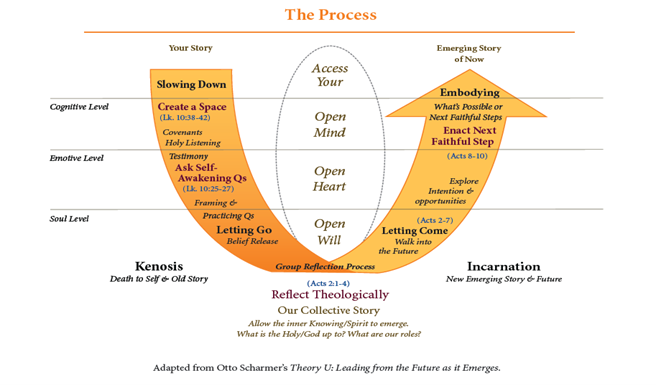LeadersCARE: a Systemic Frame for Reimagining Church
Training in the practice of LeadersCARE fosters a deepened awareness and presence to our life together as the baptized. We are carried forward through the CARE practices in ways that invite a particular visitation of the intersections of our story with God’s greater story and mysterious presence to us. Those connections create an intimacy that calls us to be actors for God in the world. We become opened to the new ways in which the Spirit is speaking to the churches; freed from passivity, we begin to see how much depends on our discernment and choosing.
A generation ago, American theologian Harvey Cox suggested that the prevailing sin of the modern church is not pride but dependency – a false dependency on structures and old patterns that deaden us to the call of the Spirit on each life and our life together. Our leaning into church as institution rather than as a community of presence has weakened individual and collective initiative, leading us to think first of survival and often placing us at war with our deepest longings. LeadersCARE assists lay leaders in re-surfacing those longings and God’s call in the HERE AND NOW. The life of the Church depends on our ability to train our members to listen and respond together – by their deciding and acting, they create a different future in the shell of older structures.
Work with the CARE practices has shown this to be more than possible and in multiple contexts. LeadersCARE has been the framework for gathering as change agents in vocational discernment structures, house churches, and in intentional communities such as young adult service corps, principally the Episcopal Service Corps. These realms of our practice are cultivated spots that suggest how an ecclesial ecology of small churches might be equipped to serve the activity of the Spirit as it emerges from the center of members’ lives.
The diagram below is one way of showing the how the inner processes of the CARE practices dynamize or enable a renewed vision for the church. The “U” form is also Mobius strip – tethering our reflective and active lives, equipping us for the change that we so long to enact.

CARE is an acronym:
C – Create a space to explore our individual and collective vocations together
A – Ask self-awakening questions that help us further open to the truth of our lives
R – Reflect theologically to develop an integrated embodiment of our lived faith
E – Enact the next most faithful steps as active imaginative partners with God shaping a new creation
As CARE practitioners we learn how to create and enter a weekly gathered space that slows us down, invites us into a deep place of sharing and reflection and inward recognition that the Gospel seed sown by God has some surprisingly deep roots, even though they were beyond our immediate recognition (Mk 4: 27). The pattern of descent that this U-shape depicts, instead of closing us further upon ourselves, opens us to a deeper place where we find ourselves identifying with others engaging the same practice. Using technologies drawn from a variety of social processes and adapted to become a kind of weekly liturgy we discover a phenomenon that Henri Nouwen described in the phrase, “What is most personal is also most universal.” We practice a communion that, from its depths, gives us a heart for the world. Then we use a variety of design technologies and practices to design innovative ministries that give us, even in small communities of faith, an ability to respond to the needs of our times, to be the body of Christ that Jesus prayed we would become (Jn. 17: 22-23).
